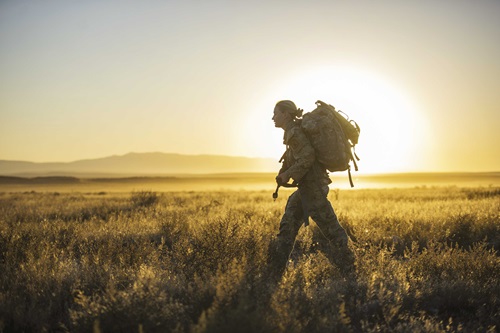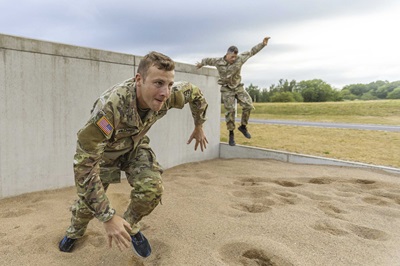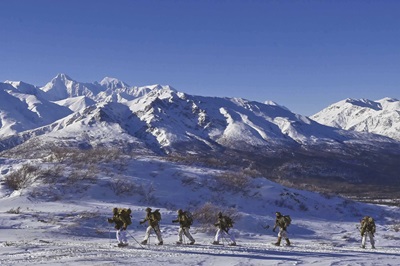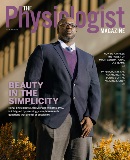On the Frontlines
Physiologists strive to improve military personnel’s experiences and environments.
By Katherine O’Brien

When Stephanie Marshall, PhD, CPT, was working as a postdoc focusing on chronic disease research, she felt an itch to move in a new direction. In her mid-30s, she was “free and single” and wanted some adventure in her life. Academia was starting to feel stale, and she couldn’t picture herself as an academic principal investigator for the long term.
Marshall also wanted to serve her country, which perhaps made her a perfect candidate for the U.S. military’s 71 Bravo program, which recruits physiology PhDs to do research. “I fell in love with science again when I joined the Army as a researcher. My values align with the mission, and it’s easy for me to feel the purpose of the work done in the Army,” she says.
Stepping out of academia into military research as a commissioned officer proved to be the right move for Marshall, now an Army captain and program manager for both the blood and shock resuscitation and hemorrhage and vascular dysfunction programs at the U.S. Army Institute of Surgical Research in San Antonio. Marshall, who would like to eventually work in a deployed unit, is the only commissioned officer featured in this article—the others are civilian employees—but all of them started out in academia, and all point to the direct effect their research has on the end user as one of the pluses of working in a military environment.
“I can see some of the direct applications of my work somewhat more immediately, or they seem closer to me because I work with people in uniform” who might get deployed or sent off for special training at any time, says Nisha Charkoudian, PhD, FAPS, chief of the Thermal and Mountain Division at the U.S Army Research Institute of Environmental Medicine (USARIEM) and an expert on the integrative physiological responses to environmental extremes of heat and high altitude.
Marshall says academia is more focused on understanding all the nuances of getting the best model and the best drug, while “in an ideal scenario, [the Army] can give money for three years and you’ll go from zero to a product.”
Helping polytrauma survivors
Marshall is trying to find a drug that can extend the survival of soldiers who have hemorrhage, orthopedic trauma and radiation injury. Recently, her team conducted a study—the first study to investigate this type of polytrauma over days as opposed to hours—that showed that the measures of kidney function in rats with multimodal injuries had a decrease in protein concentrations in the blood. This doesn’t match up with the glomerular filtration rate and most likely indicates a gastrointestinal injury from radiation exposure, Marshall says. “I would love to figure that out. It’s complicated and complex and takes various thought and dedication, but if we could get more insight there, that would be very exciting,” she says.

Marshall points out that each case of trauma is different. “Patients rarely have a similar etiology, and their responses are all different depending on their current physiological state or background,” she says. She loves how dynamic the research is—the only downside is that she must switch gears very quickly at times.
The U.S. Department of Defense is one of the rare entities that funds trauma research. In fact, science and technology programs received more than $22 billion in direct appropriations across the Defense Department—more than 18% above fiscal year 2022 funding and nearly $6 billion more than requested, according to National Defense magazine. Still, the funding for individual projects isn’t necessarily stable. “You can get really involved in an area of focus here and really fall in love with it and get some momentum, but then you get a new commander or a director or Congress changes; then, all of a sudden, the funding for that topic is no longer there,” Marshall says.
Preventing extreme heat-related illnesses
Charkoudian, who left an 11-year career as a faculty member at the Mayo Clinic in Rochester, Minnesota, describes her current workplace as a hybrid between a military post and an academic department. Although many of the day-to-day tasks are similar to those in academia, the culture is a little different—she had to learn about military ranks, for example. Plus, all research must go through a clearance process before it is published or presented. “You need a certain level of patience to deal with some of the red tape or bureaucracy surrounding some of the processes that we need to do in order to get our research done,” she says.
The research USARIEM does around understanding responses and adaptations to heat exposure is becoming increasingly relevant as climate change continues, she says. Each year, on training bases, soldiers collapse from heat exhaustion, and someone dies from exertional heat stroke every few years. “It’s just not acceptable,” Charkoudian says. “It’s so tragic and so sad. … It’s rare, but it does happen.” Her division is working toward more definitive practices that can prevent heat-related illnesses and death from happening on the battlefield and in training bases.
Charkoudian is particularly excited about research she’s done showing that female reproductive hormones (estradiol and progesterone) have significant influences on autonomic regulatory pathways that can alter thermoregulatory and cardiovascular responses during exercise in extreme heat. “With increasing combat roles and various roles open to women over the past five to seven years, it’s important that we dispel any myths that might be still out there about women being somehow more fragile,” she says. She points out that some research on sweating shows that women on average sweat less than men during intense exercise, which—if that research bears out—can be an advantage or a disadvantage depending on the situation. More studies need to be conducted on women in terms of military relevance and exercise as most of the research has been conducted on men, she adds.
Enhancing the performance of military organizations
Improving performance at high-altitude is the type of research that most intrigues Charkoudian’s colleague, Roy Salgado, PhD, USARIEM research physiologist. In 2014, while working as a non-tenure track professor, he applied for a postdoctoral research fellowship to help further his goal of becoming a tenure-track professor. The Thermal and Mountain Division was a natural fit: Salgado grew up in a military family, and his graduate research looked at the impact of high altitude on the human body.
 Now an Army civilian employee, Salgado has not ruled out going back to academia, but right now he’s enjoying his current position, which allows him to mentor and train junior USARIEM staff. He also appreciates that the institute has some of
the best resources available to conduct intricately designed studies. He points to USARIEM’s hypobaric chamber—which can simulate almost any environment on earth—located in its research facility in Natick, Massachusetts, and its
Pikes Peak High Altitude Research Facility, located on the summit of Pikes Peak at about 14,115 feet in Cascade, Colorado.
Now an Army civilian employee, Salgado has not ruled out going back to academia, but right now he’s enjoying his current position, which allows him to mentor and train junior USARIEM staff. He also appreciates that the institute has some of
the best resources available to conduct intricately designed studies. He points to USARIEM’s hypobaric chamber—which can simulate almost any environment on earth—located in its research facility in Natick, Massachusetts, and its
Pikes Peak High Altitude Research Facility, located on the summit of Pikes Peak at about 14,115 feet in Cascade, Colorado.
“What I’m really challenged with is trying to find those potential countermeasures or solutions to mitigate performance decrements,” Salgado says. Since the 1960s, high-altitude researchers have been trying to mitigate the problem of decrements in endurance performance, but so far, he says, the only effective solution is through altitude acclimatization (residing at operating altitude for a prolonged period) or altitude staging (residing at a low altitude before going to higher altitude). As he points out, both strategies require access to high-altitude areas.
Although his research is applicable to anyone who spends time in high-altitude environments, such as rescue workers or hikers, the primary end users are military organizations, such as the Colorado Army National Guard. He regularly talks to such organizations about the performance challenges they face in high altitude, working with them to design solution-oriented research projects.
One such project studies whether the combination of erythropoietin (EPO) and acetazolamide can improve the performance of endurance tasks at high altitude.
Acetazolamide stimulates the body to breathe more but does not augment endurance performance, while EPO, which increases the number of red blood cells and thus the ability to carry oxygen, has been shown to have ergogenic benefits at sea level, Salgado says. He adds that it’s also unclear whether combining the physiological responses of these two pharmaceuticals will have ergogenic benefit at altitude.
Getting the inside scoop
Having conversations with end users is also a critical part of the work of John Harrell, PhD, research physiologist at the 711th Human Performance Wing, U.S. Air Force Research Laboratory, Wright-Patterson Air Force Base, in Dayton, Ohio. In fact, some of his research projects are based on anecdotes from airmen and airwomen, including one that investigates whether exposure to heat, dehydration and mild hypobaria (low pressure) has a detrimental effect on flight-relevant tasks. Harrell was surprised to learn that the heat inside a jet can significantly affect acute respiratory function—he had no idea how hot airplanes could get until he talked to pilots. (Harrell is not allowed to disclose the temperature inside fighter jets.)
Harrell originally planned to stay in the academic world for life, but, like Charkoudian, he had to rethink career plans after a move. While in academia, Harrell, who loves studying the cardiovascular system, researched blood flow responses to stressors in different groups. He points out that researchers pursuing National Institutes of Health funding have a bit more leeway to generate research ideas than those in the military. Still, he can sometimes find “that sweet spot” where his research interests align with the Air Force’s mission to sustain or enhance the performance of airmen and airwomen. For instance, one of his projects investigates physiological variables such as venous compliance and arterial stiffness that might help pilots better tolerate acceleration.
Harrell has been surprised by the complexity of the work, everything from how money flows for research projects to regulations in terms of what can and cannot go into the human centrifuge or hypobaric chambers and who can be used as subjects. In academia, your subjects could be almost anyone if they fit your inclusion criteria—not so in the Air Force, Harrell says. “You can’t just pull someone off the street,” but must keep a pool of trained active-duty airmen and airwomen on hand.
One of his goals is to let physiologists know about research opportunities in the military. Most aerospace physiologists, like Harrell, have backgrounds in exercise or integrative physiology. “You’ve got to come in with open eyes and open ears because of the lack of programs. … You’ve got to be willing to absorb as much information as you can about airplanes, about the aerospace environment. You’ve got to be willing to ask questions.”
That’s probably sound advice for anyone doing physiology research in the military. The more questions you ask, the easier it will be to find solutions to the medical problems faced by those who serve on land, sea and air.
This article was originally published in the January 2024 issue of The Physiologist Magazine. Copyright © 2024 by the American Physiological Society.
“I fell in love with science again when I joined the Army as a researcher. My values align with the mission, and it’s easy for me to feel the purpose.”
Stephanie Marshall, PhD, CPT
The Physiologist Magazine
Read the Latest Issue
Don’t miss out on the latest topics in science and research.
View the Issue Archive
Catch up on all the issues of The Physiologist Magazine.
Contact Us
For questions, comments or to share your story ideas, email us or call 301.634.7314.


